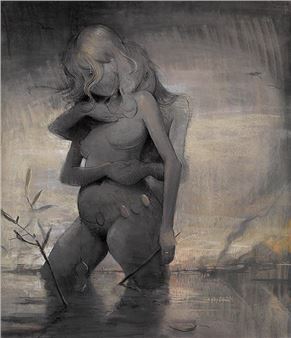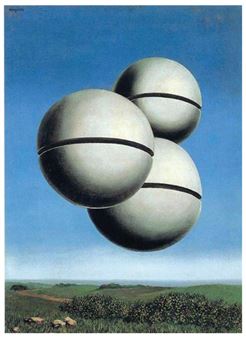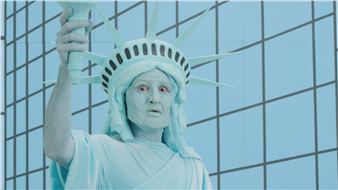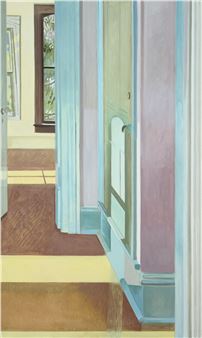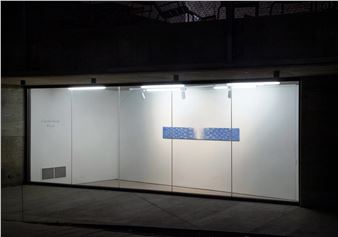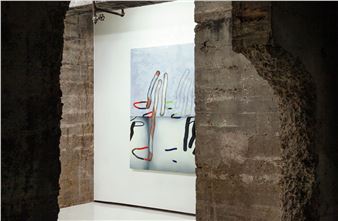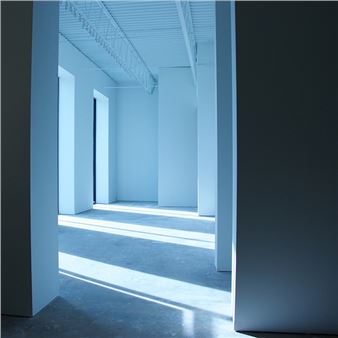Screen Door
A screen door allows circulation: of air, light, conversation. It is a porous boundary, used to mark the transition between inside and out, the personal and public. In the South and beyond, the screen door, like the porch, is a social mediator. It exposes the home to the neighborhood, while still maintaining a veil of privacy. In summer's heavy heat, it is of the utmost importance. The four painters in this exhibition have set up a screen, a scrim, a partition in their paintings that allows them to operate within the exterior, coaxing out the mercurial habits of painting behind a seemingly sound surface.
Ann Craven has appropriated images of bird photography to deconstruct ideas of duration and seriality. Using a tropical palette mixed on another canvas, Craven renders the birds as iterations of themselves, as if they were photographed in a high-speed burst like Étienne-Jules Marey. But instead of being captured in the swift applause of flight, they sit so still they might as well be taxidermied. After the bird is painted, leftover paint is applied in minimalist swaths of colors on another canvas of the same size. Finally, the palette painting is displayed as well. These three accumulations of paint on canvas playfully question notions of materiality and representation, asking the viewer to look past what has been painted in order to see the act of artmaking itself.
In her densely layered paintings, Dana Frankfort investigates the liminal zone between language and sight. Beginning with a word, not so much as a linguistic prompt, but as a dissociated point of departure, she lays down washes of oil. As the surface thickens, forms overlap, colors adulterate. The surface is sanded down. She starts again. The result has no clear relation to the semiotic starting place, and any attempt to connect the word with the work is bound to frustrate: a perfect allegory for chasms between observation, thought, and language.
EJ Hauser's singular compositions tumble through categorization. The determined, though indeterminate line work seems both pixelated and prehistoric as her pictographic subject matter shapeshifts from landscape to still life to figure to back again. In a similar circulation, her finished paintings seem like inspirations for their own preparatory sketches. Hauser locks the eye in a whirling cycle of chance and causality, dodging expectation at every turn.
Margaux Ogden paints on raw canvas, undercutting her exacting compositions with a delicate, hand-drawn touch. Each painting is a performance in which there can be no false steps; nothing can be painted over, nor redone. As such, she walks a thin stage between the material backdrop of the canvas and the art-historical barricades of geometric abstraction and minimalism. Here, she refreshes the dogmas of nonrepresentation with a liberating breeze.
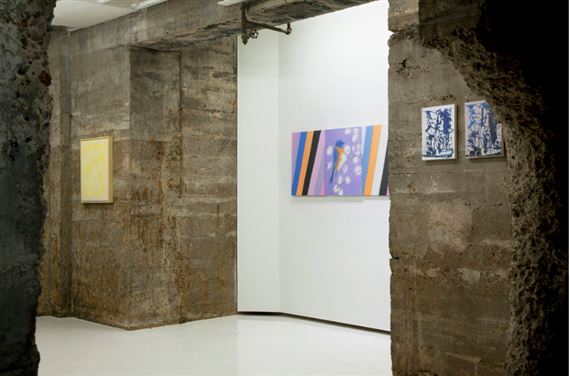
Recommended for you
A screen door allows circulation: of air, light, conversation. It is a porous boundary, used to mark the transition between inside and out, the personal and public. In the South and beyond, the screen door, like the porch, is a social mediator. It exposes the home to the neighborhood, while still maintaining a veil of privacy. In summer's heavy heat, it is of the utmost importance. The four painters in this exhibition have set up a screen, a scrim, a partition in their paintings that allows them to operate within the exterior, coaxing out the mercurial habits of painting behind a seemingly sound surface.
Ann Craven has appropriated images of bird photography to deconstruct ideas of duration and seriality. Using a tropical palette mixed on another canvas, Craven renders the birds as iterations of themselves, as if they were photographed in a high-speed burst like Étienne-Jules Marey. But instead of being captured in the swift applause of flight, they sit so still they might as well be taxidermied. After the bird is painted, leftover paint is applied in minimalist swaths of colors on another canvas of the same size. Finally, the palette painting is displayed as well. These three accumulations of paint on canvas playfully question notions of materiality and representation, asking the viewer to look past what has been painted in order to see the act of artmaking itself.
In her densely layered paintings, Dana Frankfort investigates the liminal zone between language and sight. Beginning with a word, not so much as a linguistic prompt, but as a dissociated point of departure, she lays down washes of oil. As the surface thickens, forms overlap, colors adulterate. The surface is sanded down. She starts again. The result has no clear relation to the semiotic starting place, and any attempt to connect the word with the work is bound to frustrate: a perfect allegory for chasms between observation, thought, and language.
EJ Hauser's singular compositions tumble through categorization. The determined, though indeterminate line work seems both pixelated and prehistoric as her pictographic subject matter shapeshifts from landscape to still life to figure to back again. In a similar circulation, her finished paintings seem like inspirations for their own preparatory sketches. Hauser locks the eye in a whirling cycle of chance and causality, dodging expectation at every turn.
Margaux Ogden paints on raw canvas, undercutting her exacting compositions with a delicate, hand-drawn touch. Each painting is a performance in which there can be no false steps; nothing can be painted over, nor redone. As such, she walks a thin stage between the material backdrop of the canvas and the art-historical barricades of geometric abstraction and minimalism. Here, she refreshes the dogmas of nonrepresentation with a liberating breeze.

 ARTISTS
ARTISTS








